Pool Terms
Coping
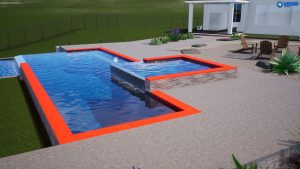 Pool coping is the material or structure that is installed at the top edge of a swimming pool, serving both functional and aesthetic purposes. Its primary function is to cap the pool shell wall and provide a finished look, but it also plays a crucial role in directing water away from the pool and preventing it from seeping into the surrounding ground. Additionally, pool coping can enhance the overall design and safety of the pool area.
Pool coping is the material or structure that is installed at the top edge of a swimming pool, serving both functional and aesthetic purposes. Its primary function is to cap the pool shell wall and provide a finished look, but it also plays a crucial role in directing water away from the pool and preventing it from seeping into the surrounding ground. Additionally, pool coping can enhance the overall design and safety of the pool area.
Pool coping materials commonly used have variance and finish details that are often concerning to clients. The porous nature, variations in stone, and scratching are a common question that need to be understood clearly before choosing a product.
Here are some key aspects of pool coping:
Materials: Pool coping can be made from various materials, each offering different aesthetics and functional properties. Common materials include natural stone (such as travertine, limestone, or slate), concrete, brick, tile, and even synthetic materials like precast concrete or fiberglass.
Profiles: Coping comes in different profiles or shapes. Some common profiles include bullnose (rounded edge), square edge, and cantilevered coping, each providing a distinct visual appeal.
Aesthetics: Pool coping contributes significantly to the overall aesthetic of the pool area. The choice of material, color, and profile can complement the pool’s design, the surrounding landscape, and the architectural style of the property. The pool coping connects to the pool deck with a mastic joint that keeps the coping from cracking when the concrete expands and contracts. Since the pool coping is right next to the pool deck the color choices are important. At Blue Ox Pools we provide the client with design meetings at supplier locations and home to find what best fits the project.
Maintenance: Different coping materials require varying levels of maintenance. Some may need periodic sealing to protect against water damage and UV exposure, while others may only require routine cleaning to maintain their appearance. Sealing the coping is a common question and comes with a variety of answers.
Waterline tile
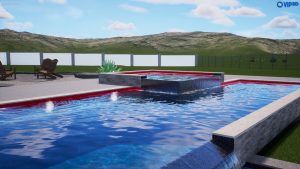 Pool waterline tile is a specialized type of tile designed to be installed at the waterline of a swimming pool. This area is where the pool’s water meets the pool’s structure, and waterline tiles serve both functional and aesthetic purposes. Here are some key features and aspects of pool waterline tile:
Pool waterline tile is a specialized type of tile designed to be installed at the waterline of a swimming pool. This area is where the pool’s water meets the pool’s structure, and waterline tiles serve both functional and aesthetic purposes. Here are some key features and aspects of pool waterline tile:
Material: Waterline tiles are commonly made from materials that are resistant to water, chemicals, and exposure to sunlight. Common materials include ceramic, porcelain, glass, natural stone (such as travertine or slate), and even mosaic tiles.
Design and Patterns: Waterline tiles are available in a wide variety of designs, colors, and patterns. These tiles allow pool owners to customize the look of their pool and enhance its aesthetic appeal.
Functionality: The primary function of waterline tiles is to create a barrier that protects the pool structure from the chemicals in the water. Pool water contains chemicals such as chlorine to maintain hygiene, and these chemicals can deteriorate certain materials over time. Waterline tiles act as a protective layer, preventing direct contact between the pool water and the pool structure.
Easy Maintenance: Waterline tiles are relatively easy to clean and maintain. Their smooth and non-porous surfaces resist the buildup of algae, mold, and other contaminants. Regular cleaning with pool-safe tile cleaners can help keep them looking pristine. Calcium build up is a common problem in various areas. Water can make its way through the grout. The main thing is regular cleaning of this since sealing doesn’t help.
Negative edge spillway
 A negative edge pool, also known as an infinity pool or vanishing edge pool, features a design where one or more edges appear to merge with the surrounding landscape, creating a visually stunning effect. The term “negative edge” refers to the illusion that the water has no visible boundary, giving the impression that it extends infinitely. The pool’s water level is typically the same as the surrounding surface, and it overflows over one or more edges, creating a spillway. Here are some key features and aspects of the negative edge pool spillway:
A negative edge pool, also known as an infinity pool or vanishing edge pool, features a design where one or more edges appear to merge with the surrounding landscape, creating a visually stunning effect. The term “negative edge” refers to the illusion that the water has no visible boundary, giving the impression that it extends infinitely. The pool’s water level is typically the same as the surrounding surface, and it overflows over one or more edges, creating a spillway. Here are some key features and aspects of the negative edge pool spillway:
Spillway Design: The spillway is the point where water flows over the edge of the negative edge pool. It is often designed to be level with the pool’s water level, creating a seamless transition between the pool and the surrounding landscape.
Infinity Effect: The spillway is a crucial component in creating the infinity or negative edge effect. The water overflows the edge, and due to the pool’s design and the angle of the spillway, it appears to vanish, creating a stunning visual illusion that the water extends infinitely.
Aesthetic Appeal: Negative edge pool spillways are popular for their aesthetic appeal. They add a touch of luxury and sophistication to the pool design, especially in settings with scenic views. The continuous flow of water over the edge creates a soothing and captivating visual effect.
Negative edge pools with spillways are a popular choice for high-end residential and resort settings, providing a combination of architectural elegance, visual appeal, and a connection to the surrounding landscape.
Thing to know: Negative edges are quiet and very lightly disturb the water. They make the tile look shiny where the water flows and dull where is dry. It is best to minimize tile outside of the flowing water so the dingy tile doesn’t remove the appeal of the shiny tile. Let’s talk more about this at a consultation.
Another type of negative edge that allows more water activity is a forward edged spillway: This edge creates more water disturbance.
Spa veneer split face
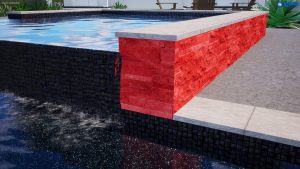 Raised spas can be adorned with a thin layer of split face stone material for decorative purposes. This finish can provide a rustic or textured look, adding visual interest to the spa’s exterior.
Raised spas can be adorned with a thin layer of split face stone material for decorative purposes. This finish can provide a rustic or textured look, adding visual interest to the spa’s exterior.
Common materials used for split face veneers include natural stones like slate, travertine, or quartzite, as well as manufactured stone products that replicate the appearance of natural stone. The split face finish creates a visually appealing texture that can enhance the overall aesthetic of the spa, giving it a more natural and earthy feel.
It is important not to use the cheaper limestones and sandstones we commonly see installed. These materials do not hold up well over time.
Water features:
In most cases it is not ideal to water features into the standard circulation system. This tends to remove flow from the circulation and spa spillway. It also does not allow these features to function in spa mode. It can be done but it comes with a set of constraints.
Deck jet
 A pool deck jet water feature is a decorative element added to a swimming pool area to enhance the overall visual appeal and create a dynamic and interactive experience. Deck jets are devices that shoot arcs of water into the pool or other designated areas, creating a playful and aesthetically pleasing effect. Here are some key features and aspects of pool deck jet water features:
A pool deck jet water feature is a decorative element added to a swimming pool area to enhance the overall visual appeal and create a dynamic and interactive experience. Deck jets are devices that shoot arcs of water into the pool or other designated areas, creating a playful and aesthetically pleasing effect. Here are some key features and aspects of pool deck jet water features:
Installation: Deck jets are typically installed at the deck level of the pool, embedded into the pool’s surrounding deck or coping. They can be strategically placed to shoot streams of water across the pool or into specific areas.
Water Streams: The jets shoot streams of water into the air, and the length and arc of the streams can often be adjusted to create different visual effects. Some deck jets are designed to produce a single stream, while others may have multiple nozzles for a more intricate display.
LED Lighting: Many pool deck jet water features come with integrated LED lighting, allowing for a vibrant display of colors in the water streams. This feature is particularly effective at night, enhancing the visual impact of the water feature.
Interactivity: Deck jets can be interactive, allowing users to control the timing and sequence of water streams. This adds an element of playfulness and engagement for pool users.
Aesthetic Enhancement: Beyond their interactive nature, deck jets contribute to the overall aesthetics of the pool area. They provide a contemporary and visually appealing element, especially when combined with other design features like lighting, landscaping, and pool finishes.
Customization: Pool deck jets come in various designs and styles, offering options for customization based on the pool owner’s preferences and the overall design theme of the pool area.
Sound Effects: The sound of water shooting through the air and splashing into the pool can add a soothing auditory element to the pool environment.
Water Conservation: Deck jets typically use recirculated water from the pool, making them relatively water-efficient. They are not designed for significant water consumption but rather for aesthetic and entertainment purposes.
Whether for residential pools or commercial pool settings, deck jet water features are a popular choice to add excitement, visual interest, and a touch of luxury to the pool area. They can be integrated into both new pool designs and added to existing pools during renovations.
Water sheer
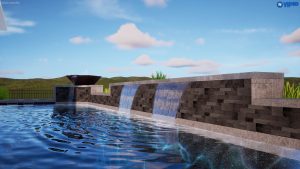 A water sheer, also known as a sheer descent or waterfall sheer, is a popular water feature often incorporated into swimming pools or other water environments. It consists of a thin, uniform sheet of water flowing vertically or at a slight angle, creating a visually striking and elegant effect. Here are some key features and aspects of a water sheer in a pool:
A water sheer, also known as a sheer descent or waterfall sheer, is a popular water feature often incorporated into swimming pools or other water environments. It consists of a thin, uniform sheet of water flowing vertically or at a slight angle, creating a visually striking and elegant effect. Here are some key features and aspects of a water sheer in a pool:
Design and Appearance: A water sheer is characterized by a sleek and continuous sheet of water that appears to flow seamlessly from a horizontal or slightly inclined spillover edge. It provides a modern and sophisticated aesthetic to the pool.
Materials: Water sheers are typically constructed using materials such as stainless steel or acrylic. Stainless steel sheers are durable and resistant to corrosion, while acrylic sheers may allow for more creative designs and lighting effects.
Width and Height: The width and height of a water sheer can vary based on design preferences and the specific installation. Some sheers are narrow and produce a delicate, fine sheet of water, while others may be wider for a more dramatic effect.
Illumination: Many water sheers incorporate LED lighting to enhance the visual impact. Colored lighting can be added to create vibrant displays during the day and night, transforming the water feature into a captivating focal point.
Adjustable Flow: Some water sheers offer adjustable flow rates, allowing users to control the intensity of the water sheet. This flexibility can be useful for creating different visual effects and accommodating various preferences.
Sound Effects: The sound of water cascading down the sheer can add a soothing and tranquil ambiance to the pool area. The sound level can be adjusted based on the flow rate and design.
Installation: Water sheers are typically installed at the edge of a pool or another water feature. The installation may involve embedding the sheer into the pool wall or using a separate structure, depending on the specific design and pool configuration.
Integration with Pool Systems: Water sheers can be integrated into the pool’s circulation system, recirculating water from the pool. This makes them relatively water-efficient and easy to maintain.
Water sheers are popular in both residential and commercial pool designs, providing a contemporary and luxurious touch to the overall pool environment. They can be used as standalone features or incorporated into more elaborate pool designs with additional water features and landscaping.
Bubbler and led bubbler
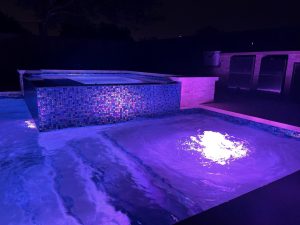 Pool bubblers and LED bubblers are water features designed to add visual interest, movement, and ambiance to a pool or other water feature. Let’s explore the characteristics and distinctions of each:
Pool bubblers and LED bubblers are water features designed to add visual interest, movement, and ambiance to a pool or other water feature. Let’s explore the characteristics and distinctions of each:
Pool Bubbler:
Operation: A pool bubbler is a water feature that forces water up from under the water through the waters surface.
Installation: Bubblers are typically installed in shallow areas of the pool, such as sun shelves or steps, where the water is not too deep.
Effect: Bubblers are known for creating a lively and playful atmosphere in the pool. They can be synchronized to operate in patterns or sequences for added visual appeal.
Safety: Bubblers are generally safe and suitable for all ages. They add a dynamic element to the pool experience without strong currents or splashing.
LED Bubbler:
Operation: An LED bubbler combines the water disturbance effect with built-in LED lights. These lights can change colors, creating a visually stunning display.
 Color Options: LED bubblers often offer a range of color options, and some models may even have programmable lighting sequences. This allows pool owners to customize the lighting to match their preferences or special occasions.
Color Options: LED bubblers often offer a range of color options, and some models may even have programmable lighting sequences. This allows pool owners to customize the lighting to match their preferences or special occasions.
Installation: Similar to regular bubblers, LED bubblers are installed in specific areas of the pool where the bubbling effect is desired. They are connected to the pool’s electrical system for lighting control.
Visual Impact: LED bubblers enhance the visual impact of the bubbling effect, especially during nighttime or evening pool use. The combination of bubbling water and changing LED colors can create a mesmerizing display.
Energy Efficiency: Many LED bubblers are designed to be energy-efficient, using LED technology that consumes less power than traditional lighting systems.
Both pool bubblers and LED bubblers contribute to the aesthetics and entertainment value of a pool. They are often used in residential pools, resort pools, and other aquatic settings to create a unique and enjoyable atmosphere. The choice between a standard pool bubbler and an LED bubbler depends on individual preferences, desired visual effects, and the overall design concept of the pool area.
